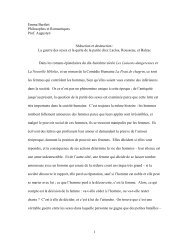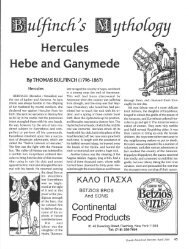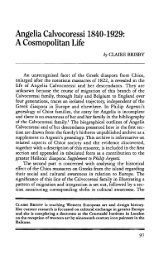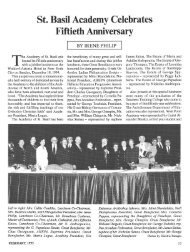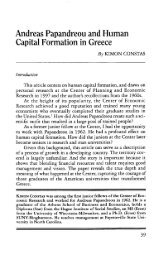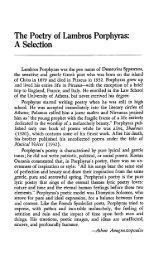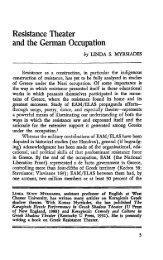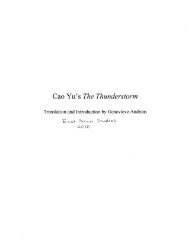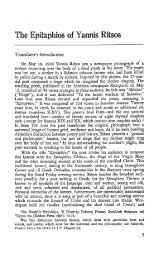THE FAYUM PORTRAITS AND THE DOXIADIS CLAN
THE FAYUM PORTRAITS AND THE DOXIADIS CLAN
THE FAYUM PORTRAITS AND THE DOXIADIS CLAN
You also want an ePaper? Increase the reach of your titles
YUMPU automatically turns print PDFs into web optimized ePapers that Google loves.
<strong>THE</strong> <strong>FAYUM</strong> <strong>PORTRAITS</strong><br />
<strong>AND</strong> <strong>THE</strong> <strong>DOXIADIS</strong> <strong>CLAN</strong><br />
By IRIS LILLYS<br />
This past fall an extraordinary book<br />
was published. London was where it first<br />
saw the light. Then came Paris where it<br />
has been referred to as "Le livre des<br />
livres" and where the Academie des<br />
Beaux Arts honored it with the award<br />
of the year. Last but not least, this past<br />
November, the famous Harry N. Abrams<br />
Publishing House of New York<br />
produced the superb American edition.<br />
One does not have to be an artist or<br />
a lover of painting to rave about this<br />
book. An average degree of culture and<br />
eye for beauty suffice to make one marvel<br />
on this masterpiece. This publication<br />
is not about Greek art in the proper<br />
sense of the word. It is much more, as it<br />
is the influence of Greek art that produced<br />
those famous Fayum portraits.<br />
The writer, Euphrosyne Doxiadis<br />
who had been researching her material<br />
for more than seven years, tells us that<br />
"the glory that used to be Greece had<br />
influenced this part of the world." Of<br />
course, she is referring to Egypt... In the<br />
foreword of the book, Professor Dorothy<br />
J. Thompson of Girton College,<br />
Cambridge, England, agrees:<br />
"In those painted portraits the tradition<br />
of Greece became joined to ancient<br />
Egyptian practices." She is referring to<br />
mummification.<br />
A strictly Egyptian procedure, mummification<br />
gets lost in the depth of time.<br />
Even the great Greek historian Herodotus<br />
mentions it and that takes us back to<br />
the 5th century B.C. But it was only<br />
when Alexander the Great conquered<br />
Egypt for the Greeks and with three<br />
hundred years of Greco-Macedonian<br />
regime by the Ptolemies that the Greek<br />
customs got out of the capital, Alexandria,<br />
and infiltrated the Egyptian traditions.<br />
It went so far as to affect the<br />
traditional procedure of mummification.<br />
The inhabitants, those who were able to<br />
DECEMBER, 1995<br />
Another characteristic Faytini Portrait<br />
Century:<br />
70,000 tons!
afford the fees that embalmers charged,<br />
added a final touch: the painted portrait<br />
of the defund, a facial representation for<br />
the mummy's future life.<br />
"Now", says Dorothy Thompson,<br />
"almost two milleniums later, a present<br />
day Greek artist versed in the tradition<br />
of Byzantine icon-painting has come to<br />
gaze at the portraits. Thus the book took<br />
life...."<br />
Let us hear what the author has to<br />
say about the Fayum portraits.<br />
"Suddenly in the late 1880's scores of<br />
beautiful and mysterious portraits began<br />
to reach a Western Europe and the<br />
United States. They came from Egypt,<br />
12<br />
from a region called Fayoum, a short<br />
distance from Cairo. A few of these portraits<br />
were discovered earlier and others<br />
came to light since at sites outside<br />
Fayum as well, making a total of more<br />
then one thousand to date. Fayum is the<br />
name that has persisted over all others<br />
in archeology and art history describing<br />
them because more have been found<br />
there than anywhere else.<br />
"The Fayum portraits is the most outstanding<br />
body of paintings to have come<br />
to us from the ancient world, remarkable<br />
for their social and psychological<br />
insight and for their quality of art. Andre<br />
Malraux described them as glowing<br />
with a flame of immortal life. Products<br />
of the Greek naturalistic tradition, the<br />
best of them painted directly from life,<br />
they have by some miracle of painting<br />
captured life itself..."<br />
"Yet", continues Euphrosyne, "those<br />
portraits have constantly been neglect-<br />
ed by historians and critics and are practically<br />
unknown to the general public..."<br />
Asked what she thought was the reason<br />
for this misconception, Euphrisyne says<br />
she can think of three reasons:<br />
First -- those portraits are not signed<br />
by any known artist. Even the same Fay-<br />
oum has been objected as not all portraits<br />
were discovered in the Fayum region.<br />
They are what is called "victims of<br />
aninymity."<br />
Secondly-- they are scattered all over<br />
the world, sometimes in different sec-<br />
tions of the same museum: as Greek<br />
portraits of Egyptian mummies which<br />
date from the Greco-Roman period,<br />
they are often found in the Egyptian,<br />
Greco-Roman and Coptic department.<br />
And, Thirdly -- they were initially<br />
dogged by the reputation that they<br />
might be fakes as they had been so overrestored<br />
by their collectors that all<br />
seemed possible.<br />
The author of this book is a painter<br />
in her own right. Born in Athens, she<br />
was lucky enough to have had as her first<br />
teacher, rather her mentor in art, the<br />
famous Yannis Tsarouchis. There is no<br />
doubt that her interest in the Fayum<br />
portraits was kindled by him as he himself<br />
had been greatly influenced by the<br />
Egyptian portraits. Her studies later in<br />
Europe and the U.S.A (Oscar Kokoscha<br />
School of Painting in Austria, The Slade<br />
School of Fine Arts in London, the<br />
Cranbrook Academy of Art in Michigan<br />
and lately the Wimbledon School<br />
of Art in London), all but developed her<br />
desire to look deeper into what she calls<br />
the first surviving portraiture in history.<br />
Euphrosyne's Doxiadis comes from<br />
a well-known and very respected family<br />
in Greece. Her grand father, Dr. Apostolos<br />
Doxiadis, a pediatrician, was born<br />
in what used to be called Anatoliki<br />
Roumelia, the Greek speaking province<br />
of Bulgaria. The family was well off and<br />
the two sons were sent to Germany to<br />
study medicine. (Actually the grand fa-<br />
GREEK-AMERICAN REVIEW
thers' brother had remained in Germany<br />
where he baceme a university professor<br />
of surgery). Dr. Doxiadis had also<br />
served in Eleftherios Venizelos' government<br />
as Secretary of Health. He had<br />
four sons, all of them gone. Thomas an<br />
internist, held the highest position in his<br />
profession and was also the Court Physician.<br />
Another son, Spiros, a pediatrician<br />
after his father, had also served as<br />
Secretary of Health under the Karamanlis<br />
regime (he is the only Greek who ever<br />
fought, but, alas, unsuccessfully, the disastrous<br />
cigarette smoking addiction in<br />
the second highest smoking country in<br />
the world, Greece). Kirkos, another<br />
Doxiadis brother had studied economics<br />
but had been all his life a charming<br />
dilettante in all phases of cultural life.<br />
The fourth brother, Dinos, was Euphrosyne's<br />
father. He had studied architecture<br />
and engineering. But his switch to<br />
city-planner made him internationally<br />
known. His firm built towns in Saudi<br />
Arabia and several other provinces of<br />
the new world. He even had an office in<br />
Washington D.C. from where his company<br />
directed works in the Midwest.<br />
Also in Athens he created a licensed<br />
school where all branches of artistic<br />
work is taught.<br />
Dino Doxiadis had three daughters.<br />
The eldest, Anthy, with a Ph. D. in children's<br />
psychological disorders, left<br />
Washington where her two children are<br />
persuing their studies to establish in<br />
Athens(with her own funds) a center for<br />
disturbed poor children, the "Perivolaki."<br />
Daughter number two, Calli, is a New<br />
Yorker. She too is a writer who devides<br />
her time between her writing and her<br />
husband's sabbaticals in Madrid where<br />
he teaches when he is not at his chair at<br />
Columbia University. He is a Greek-<br />
American and his name is Edward<br />
Malafakis.<br />
A brother is also part of the Doxiadis<br />
family. His name is Apostolos(if he<br />
lived in the States he would have been<br />
Apostolos Doxiadis the third.) He is in<br />
charge of the Doxiadis Institution in<br />
Athens but besides that his interests<br />
comprise theatre, poetry and all sorts of<br />
artistic expressions.<br />
Frossaki(that was her name when I<br />
met her in her teens) is the youngest of<br />
this very gifted family. Still in her thirties<br />
she has covered lots of ground for<br />
her age. With her first marriage she<br />
moved to London, where she stayed<br />
with her young son, Nikiforos. Her second<br />
marriage produced a daughter<br />
which is growing up showing the lovely<br />
English complexion of her father combined<br />
with the charm and personality of<br />
her maternal grandmother and namesake,<br />
Emma.<br />
Together with the development of her<br />
career, Euphrosynes' private life took finally<br />
a turn for the best. Her husband,<br />
Nikos Mouzelis, a professor at London's<br />
famous School of Economics, besides<br />
being brilliant is an ideal companion to<br />
his wife and an ardent admirer and advocate<br />
of her career.<br />
Knowing the dynamism of Mrs. Euphrosyne<br />
Mouzelis - Doxiadis, it is sure<br />
that her talents will keep on producing<br />
both paintings and books of the caliber<br />
of the "Mysterious Fayum Portraits."<br />
DECEMBER, 1995 13



